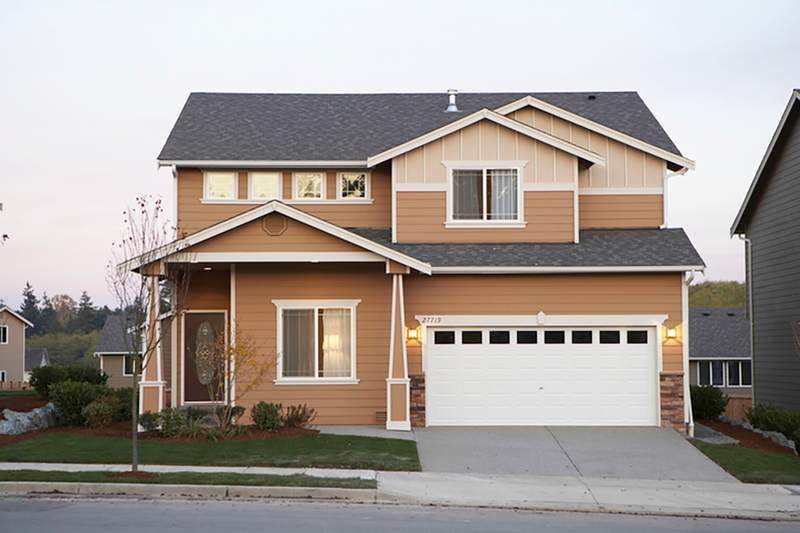When taking out a mortgage, home buyers may be caught off guard by an origination fee. This additional upfront cost can feel like an unnecessary burden on top of your down payment and other closing costs. You may wonder if you can negotiate it or whether rolling it into the loan will cost more in the long run.
In this article, we’ll give you an overview of origination fees so you have a better understanding of what you’re paying for when buying a home with a mortgage.
Key Takeaways:
- An origination fee is a lender’s upfront charge for processing a new loan. It is typically 0.5% – 1% of the loan amount.
- Borrowers can negotiate the origination fee, opt for a higher interest rate in exchange for a lower fee or have the seller cover the cost as part of the home purchase negotiation.
- You can pay the fee up front at closing or roll it into the mortgage. You can also cover it with lender credits, seller contributions or special assistance programs.
What Is An Origination Fee?
A mortgage origination fee is an upfront fee the lender charges to cover the administrative cost of processing and underwriting a new loan. Typically, a loan origination fee is expressed as a percentage of the total loan amount.
An origination fee is a standard component of the upfront closing costs that borrowers encounter when buying a house with a mortgage or refinancing an existing home loan. Closing costs can also include fees for a home appraisal, credit inquiry, wire transfers and more.
In the United States, an origination charge is generally 0.5% – 1% of the mortgage loan amount. According to data from the Federal Reserve Bank of St. Louis, the median home sale price in the U.S. was $416,900 as of Q1 2025. If you financed the entire purchase of the median home and the lender charged you a 1% origination fee, you’d owe $4,169.
You can pay the origination fee with a check or wire transfer. Alternatively, you may be able to roll the origination fee into the mortgage or cover it with credits. There’s also a chance you can negotiate the origination fee to have the seller cover it or pay a higher interest rate to offset the costs.
What’s Your Goal?
Buy A Home
Discover mortgage options that fit your unique financial needs.

Refinance
Refinance your mortgage to have more money for what matters.
Tap Into Equity
Use your home’s equity and unlock cash to achieve your goals.
How Does A Mortgage Origination Fee Work?
An origination fee typically covers a range of lender costs, including processing your loan application, underwriting the loan – which involves verifying everything from your income and assets to your job history – and preparing your mortgage documentation.
The fee is a percentage of the total loan amount and is represented as origination points by the lender. The number of points you’ll pay can vary by mortgage lender, but one point typically equals 1% of the total loan amount.
Origination Points Vs. Mortgage Discount Points
Loan origination fees and discount points are both prepaid finance charges associated with mortgages, but they serve different purposes within the loan process.
Origination points compensate the lender for the cost of processing, evaluating and approving the mortgage. Mortgage discount points, calculated similarly as a percentage of the loan amount, serve as a prepaid interest cost. By paying up front, borrowers can lower their mortgage interest rates and monthly mortgage payments.
You’ll find any discount points and the origination fee under the “Origination Charges” section of your loan estimate.
Ready To Become A Homeowner?
Get matched with a lender that can help you find the right mortgage.
How Much Is The Origination Fee On A Mortgage?
In the United States, the origination fee is generally 0.5% – 1% of the mortgage loan principal amount. But this fee can vary by lender and type of loan.
Some lenders split the origination fee into a processing fee (the cost of taking your application and collecting paperwork) and an underwriting fee (the cost of an underwriter reviewing your mortgage application for approval). Other lenders combine all services into one fee. If you’re interested in a lender that splits its fee, add up the percentages to ensure an “apples to apples” comparison of your loan options.
Though rare, some lenders may offer mortgages with no origination fee – but they typically come with higher interest rates.
Understanding the loan origination fee is crucial because it directly impacts the mortgage’s overall cost. But it’s only one component of your overall closing costs.
When comparing fees charged by lenders, know that lenders publish two rates: the base interest rate and the annual percentage rate (APR). The annual percentage rate is the base interest rate plus the loan’s closing costs. The bigger the difference between the base rate and the annual percentage rate is, the more the lender charges in closing costs and fees.
Take The First Steps To Buying A Home
Find a lender that will work with your unique financial situation.
6 Ways To Minimize The Loan Origination Fee And Closing Costs
Although most lending institutions require borrowers to cover the loan origination fee and other upfront costs, there are strategies borrowers can use to reduce them.
1. Negotiate Down
Some mortgage lenders may be willing to negotiate the origination fee. If a loan officer suspects your mortgage will close and knows you’re considering multiple loan offers, you may have more leverage to negotiate this fee.
If you want to attempt a negotiation, it can help to have multiple loan offers. After you apply for a mortgage, your lender must provide a loan estimate, including the origination fee, within three business days. Having multiple loan estimates increases your negotiation power for reducing the origination fee based on competing offers.
Pro tip: A lender may also be willing to lower their price to earn your business if you’re a low-risk borrower with sufficient income and assets and an excellent credit score. However, having lots of certain types of debt may work against you.
2. Shop Around
Shopping around and comparing lenders can help you find the most affordable loans. Use the APR to determine the total cost of each loan offer, including interest, the origination fee and any other fees, and compare them to find the best deal. Working with a mortgage broker can make the comparison process easier. A broker can find multiple lenders that offer lower APRs.
When shopping for a mortgage, be sure to compare similar loan options. For example, your rate will be different on a 30-year fixed home loan than a 5/1 adjustable-rate mortgage (ARM).
3. Get Lender Credits
Lender credits lower your closing costs in exchange for a higher mortgage rate. You can think of it as the opposite of discount points, which offer a lower interest rate in exchange for higher payments upfront.
Keep in mind that with lender credits, you’ll pay more on the loan over time. This makes lender credits a better strategy for those who don’t plan to live in a house for long.
4. Ask For Seller Concessions
If you’re able to negotiate seller concessions as part of your home purchase, this can offset the cost of the origination fee. Seller concessions are certain costs associated with a home purchase that a seller agrees to cover. If you want to use this strategy, you must include seller concessions in your purchase agreement.
However, this approach can have a few drawbacks. First, sellers may hesitate to accept an offer that asks them to pay a bunch of fees. And you may not get as much covered by concessions as you think you will. All major loan programs set caps on how much sellers can pay in closing costs. For example, concession limits for conventional loans are typically 3% – 6%, depending on the size of your down payment and your loan-to-value ratio (LTV).
5. Consider Gift Money
If you’re lucky enough to receive a gift from a family member, this money can cover your closing costs, including your origination fee. Some loans also allow gifts from nonprofit organizations, close friends, labor unions, employers or government agencies.
Keep in mind that the money you receive must be a gift. And the donor must indicate in a gift letter that you don’t have to pay them back.
6. Pay Upfront
If you can afford it, it’s best to pay your closing costs, including your origination fee, up front.
Paying upfront has a couple of advantages. First, you’ll know exactly how much you’re spending on your closing costs. You’ll also get a lower rate (and lower your monthly mortgage payment) when you pay your closing costs up front rather than rolling them into your mortgage. This approach costs more up front but will likely save you money in the long run.
Mortgage Origination Fee FAQ
Here are some additional questions you may be contemplating about the origination fee:
With a no-origination-fee loan, you pay less up front in closing costs, but you pay more in interest over the lifetime of the loan. It comes down to what’s most important to you.
Appraisal fee ($300 – $600): Determines the home’s market value
Credit report fee (up to $30): Covers the cost of checking your credit history
Title insurance (0.50% of the home’s purchase price, $2,000 on a $400,000 home): Protects against legal disputes over property ownership
Home inspection ($300–$600): Ensures the home’s condition before purchase
Escrow fees (varies): Covers third-party handling of funds and documents
Prepaid property taxes and homeowners insurance: Required up front by lenders
On average, closing costs are 2% – 5% of the loan amount, so it’s important to budget accordingly. Some lenders offer closing cost assistance programs, so ask about available options.
The Bottom Line
A mortgage origination fee is an upfront fee paid to the lender that covers the administrative costs of processing a new loan. This fee generally costs 0.5% – 1% of your loan amount, which can add thousands of dollars to your closing costs. If you don’t want to pay an origination fee up front, you may be able to roll it into the cost of your loan, negotiate it down or ask for seller concessions.
With a better understanding of the origination fee, you can start your mortgage shopping experience knowing what to expect as you prepare to buy a home.

Ben Shapiro
Ben Shapiro is an award-winning financial analyst with nearly a decade of experience working in corporate finance in big banks, small-to-medium-size businesses, and mortgage finance. His expertise includes strategic application of macroeconomic analysis, financial data analysis, financial forecasting and strategic scenario planning. For the past four years, he has focused on the mortgage industry, applying economics to forecasting and strategic decision-making at Quicken Loans. Ben earned a bachelor’s degree in business with a minor in economics from California State University, Northridge, graduating cum laude and with honors. He also served as an officer in an allied military for five years, responsible for the welfare of 300 soldiers and eight direct reports before age 25.












